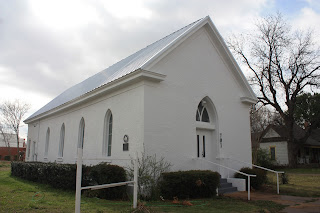"Lone Star Historian" is a blog about the travels and activities of the State Historian of Texas. Bill O'Neal was appointed to a two-year term by Gov. Rick Perry on August 22, 2012, at an impressive ceremony in the State Capitol. Bill is headquartered at Panola College (www.panola.edu) in Carthage, where he has taught since 1970. For more than 20 years Bill conducted the state's first Traveling Texas History class, a three-hour credit course which featured a 2,100-mile itinerary. In 2000 he was awarded a Piper Professorship, and in 2012 he received the Lifetime Achievement Award from the Wild West Historical Association. Bill has published over 40 books, almost half about Texas history subjects, and in 2007 he was named Best Living Non-Fiction Writer by True West Magazine.
During my nine months as State Historian I have attended meetings of the Texas State Historical Association, the East Texas Historical Association, and the West Texas Historical Association. The fourth state or regional historical association is the South Texas Historical Association, and it was my pleasure to meet with this delightful group on Saturday, April 27. Pat Parsons, Vice President of the STHA, arranged a one-day meeting in a most special location. Pat knew that I wanted to attend an STHA meeting, and she asked that I speak to the group about the duties and activities of the State Historian of Texas.
The Saturday meeting was held west of Three Rivers at Mission Sin Caja, a remarkable conference and recreational center with a strong historical flavor. Kurt House, a native of Three Rivers, built Mission Sin Caja on the family ranch, a property he still owns, along with three other area ranches. Geographically the region is flat brush country, but 10 miles south of Kurt's ranch is a 1,500-foot-tall mesa that long was used by Spanish explorers and other early travelers. A rumored event, described by J. Frank Dobie in Coronado's Children, involved a massacre at the mountain by Lipan Apache warriors. The victims were buried where they fell "sin cajas" - without boxes or coffins - and the plateau is known as "Mesa Sin Caja."
Kurt House has degrees in archaeology and architecture, and he has performed extensive post-graduate and field work. He is a noted collector of antique firearms, as I learned several years ago when he engaged me to speak at an event he staged at San Antonio's Buckhorn Saloon. Later I learned that he is a serious collector of various other items, and he has filled Mission Sin Caja with hundreds of artifacts from his collection. Kurt began Mission Sin Caja in 2005 ("Est. 1755 +/- 250 Years) as a memorial to his parents, and it was opened to the public in 2012. The "mission" was built of authentic indigenous materials: mesquite doors, window frames, mantles, lintels, local stone, Spanish tiles. It is furnished throughout with 18th and 19th century Spanish and Mexican furniture.
Pat and Chuck Parsons, and my wife Karon and I, spent Friday night at Mission Sin Caja. We explored every nook and cranny of the complex, and we spent the evening enjoying a cool breeze on the patio and listening to the howls of coyotes. Early the next morning I had a splendid walk on the ranch roads, sighting various species of wildlife and getting the feel of the land. About 30 members of the STHA arrived at mid-morning. After a get-acquainted period, Pat Parsons welcomed the crowd and introduced me. I spoke about the office of State Historian. handing out my business cards, talking about my activities, and recommending my blog, all in an effort to let as many Texans as possible know that there is indeed a State Historian.
The program was turned over to Kurt House, who explained the origins and purposes of Mission Sin Caja. He emphasized that while it is a hunting lodge and family recreation retreat, he promotes it as a living history museum for school children and as an educational center for groups such as the South Texas Historical Association. Kurt then conducted a building by building tour of his mission, taking time to point out one artifact after another.We all were in Historian Heaven.
 |
| Bill with President Homero Vera |
Finally, STHA President Homero Vera of Sarita conducted a business meeting, after which the group reluctantly departed Mission Sin Caja. For me, it was a remarkable introduction to the South Texas Historical Association.
 |
| Kurt House addresses the STHA |
 |
| VP. Pat Parsons introduces Kurt House |




















.JPG)




























